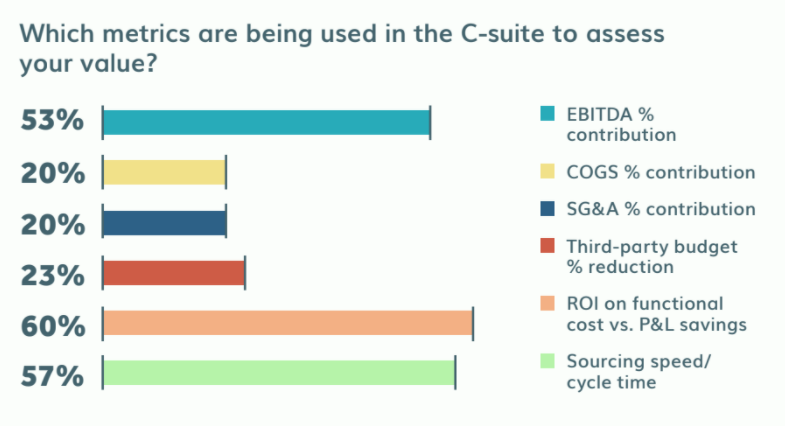Being able to generate value for the organization and prove the worth of procurement is always a top priority. But choosing the procurement metrics that matter and will accurately measure the bottom line can be a challenge. How do you select which key procurement metrics to track and how to prioritize them?
We’ve gathered ten areas where you should be prioritizing metrics in 2021, from the most essential to those that can push your business to the next level. Use these KPIs as a starting point to build a robust dashboard of procurement metrics to increase visibility and drive bottom-line results.
The Spend Analysis Basics
These are the essential performance indicators for spend management. They’re the fundamentals that every organization should be tracking and striving to improve on. Some might be new to you, or you might just need a refresher.
1. Spend Under Management
One of the most important indicators of procurement success is simply how much spend you’re actually managing, versus spend that’s outside your oversight. Maverick spend means lost opportunities and increased costs, so you want to do as much as you can to get it under control.
Your individual goal for total spend under management might vary based on the structure of your organization. For example, it might include indirect materials and MRO, or only direct materials. It might be restricted to certain business units while others manage themselves. The important thing is to set a goal that fits your organization and do everything you can to reach it.
2. Purchase Price Variance
Purchase price variance is, at its most basic, the difference between the prices you’re expecting to pay and the actual cost of items. PPV may occur because you’re not receiving expected bulk-purchasing discounts or because your pricing data isn’t up to date. Because budgets are often prepared several months before purchases are made, demand, prices and volumes can shift, creating purchase price variance.
Measuring variance allows procurement teams to identify how effective they are at actually delivering savings in practice, as opposed to expected savings on paper. Ideally, teams will drive down PPV, meaning that they’re delivering anticipated savings.
3. Strategic Supplier Management
Measuring spend with your strategic suppliers is key. Historically, experts have often advised pushing 80% of spend through 20% of your suppliers. This allows for maximum consolidation of spend and bulk discounting, while still leaving room for niche suppliers you may need less often for irregular purchases.
The nature of supplier management has shifted in the wake of COVID-19. As we’ll discuss later, diversification is increasing. But strategic supplier relationships are still a vital part of the procurement workflow, so you should make sure you’re setting a realistic goal for spend with these suppliers and sticking to it.
Metrics for Business Growth
Once your organization is running essential spend analytics tasks, you can look toward more advanced metrics. These are the KPIs that will help you grow your organization and increase the influence of procurement, especially within the c-suite.
4. Spend Influence
The Hackett Group recently named spend influence as a top ten priority in their 2021 Key Issues Report. Spend influence is the sum total of the impact procurement has on spend, from price negotiation to early payment discounts. In some organizations, this can even include procurement’s expertise with product or service selection.
As Spend Matters found in a survey of practitioners, the earlier procurement was involved in the process, the higher spend influence was. Influence can decrease purchasing costs, increase quality and lead to a better strategic partnership with other teams, so procurement should set a goal to increase this metric year by year.
5. Spend Costs
Spend costs were named The Hackett Group’s number one key issue for 2021. This metric measures savings generated by reducing current costs as compared to previous costs. Put simply, how much are you saving? This is an essential metric, and can be used to validate procurement’s value to the rest of the organization.
6. Functional Costs
Functional costs are simply how much you’re spending on the process of procurement – your team and your tools. According to a recent report from ProcureCon’s CPO Study 2021, 60% of respondents say that the c-suite is tracking ROI on functional cost versus profit and loss. This is up from 39% last year, so this is a metric that’s increasing in importance. Make sure to examine your functional costs compared to savings, and try to improve not only by increasing savings but by decreasing functional cost.
7. Sourcing Speed
Sourcing speed is another metric that’s increasing in importance in recent years. According to ProcureCon, 97% of respondents said that the importance of sourcing speed has changed, and 73% of them said its importance has increased. 57% of respondents said that the c-suite at their organization uses sourcing speed to measure the value of procurement.
Emerging Metrics for 2021
There’s no doubt that procurement priorities have shifted since the Coronavirus struck. With those changing initiatives come changes to what procurement teams should be measuring.
8. Sustainability
Sustainable procurement has been on the rise for years now, but we expect it to make further leaps forward this year. With a new administration in the U.S., many expect increased regulations. With organizations increasing their focus on sustainability procurement has taken a front seat because of the potential impact they can have on the larger company.
Identifying specific KPIs here might seem like a challenge, but there are many options. For example, you can track the number of suppliers that have sustainability certifications, or the number of recyclable products sourced. You can also leverage procurement to implement or improve paperless policies, increasing the use of electronic tools instead of physical documents.
9. Diversification & Diversity
We’ve written extensively about the benefits of having a diverse supplier base. Not only is there increased social and commercial pressure to embrace diversity and have a supply base that mirrors your employee base, but it also decreases your potential risk.
Measuring diversity and diversification is relatively simple, thanks to standardized designations for things like minority-, women-, or veteran-owned businesses. Using a supplier management tool that can segment and report on suppliers based on these designations will make your job much easier.
10. Supplier Performance
Supplier performance may seem like a baseline metric, but we think it’s particularly relevant this year. Leveraging supplier performance data is more important than ever after the devastating impacts of COVID-19 on supply chains over the past year. KPIs like on-time delivery, quality, and service can help you identify high risk suppliers and make alternative plans. That way, when things eventually go awry, you have the ability to recognize it early and pivot quickly. Tracking supplier compliance helps keep both you and your suppliers on track and minimizes unexpected disruptions.
Getting Started
If you’re already tracking metrics in these areas then you’re well ahead of the curve. If not, there’s no time like the present to get started.
JAGGAER’s source to pay platform, JAGGAER ONE, can help you better track spend analytics, supplier performance and more, taking your organization to the next level. If you’re interested in learning more about where CPO priorities lie in 2021, download The Hackett Group’s report, 2021 Key Issues.







